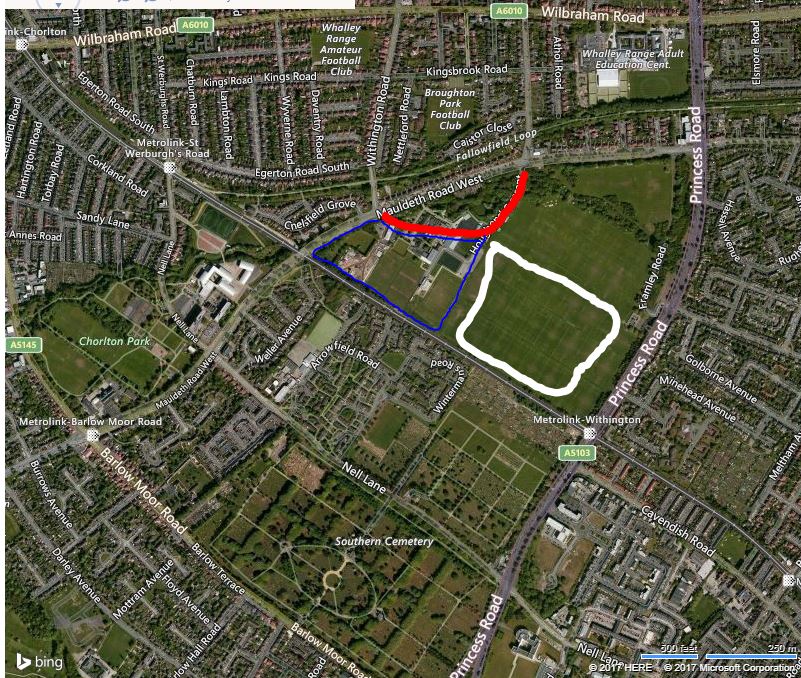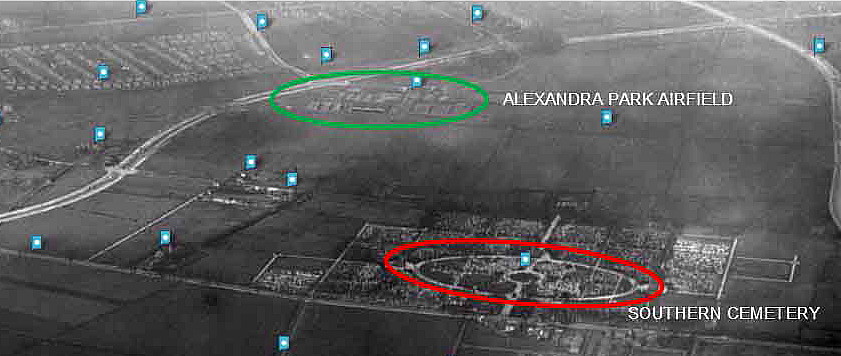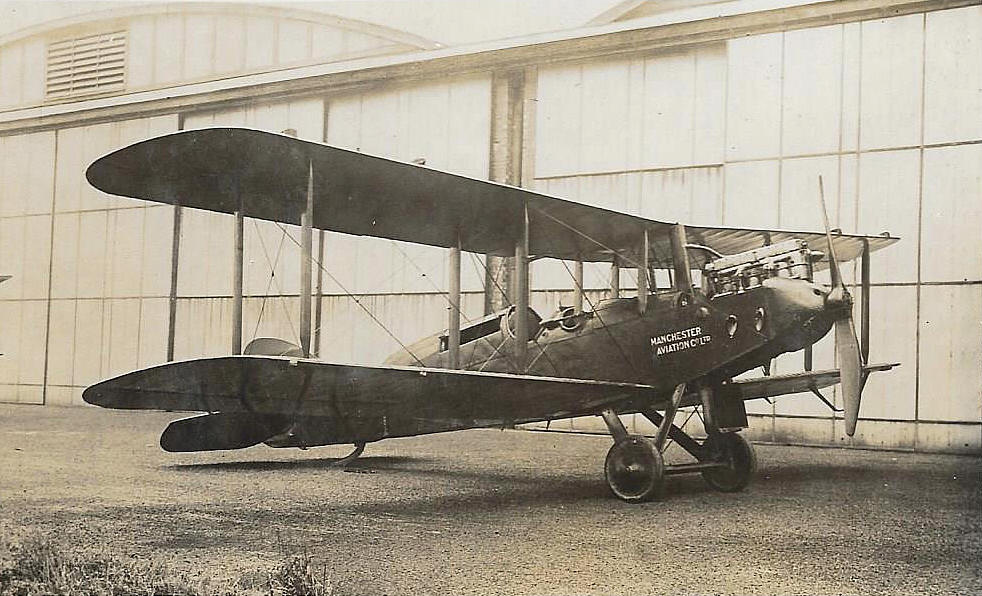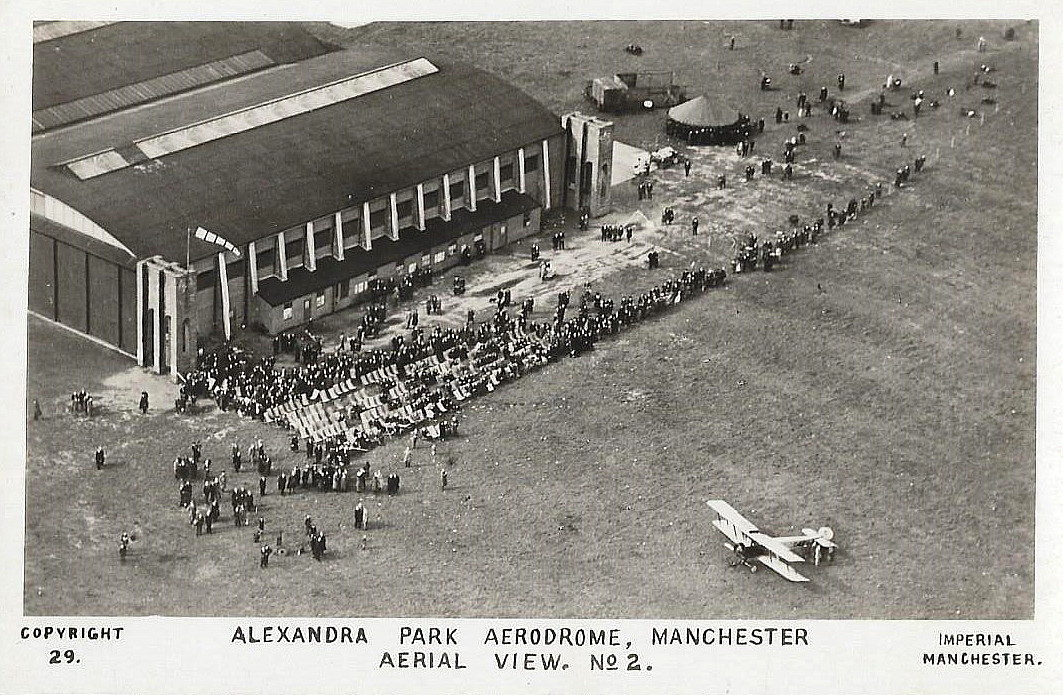Alexandra Park
Note: Some time ago I made this comment: Trying to define an exact position for this site has been a very frustrating experience. So much information of course but so little seems to define the location. I think I now have it about right but will welcome advice.
In July 2017 I was very kindly contacted by Paul Meddemmen who very generously sent me both a modern map and an old aerial picture to illustrate the site, plus pointing out that the original marker on Google Maps was not quite in the correct position. This of course has now been adjusted.
On the modern map Paul points out that the Red Line is a road, the Blue area where the hangars and other buildings were located and the White Area is where the flying took place.
On the second picture, scanned from 'Britain from Above', the whole site is clearly visible.
The third picture of the DH.9 and the aerial photo are from postcards and kindly sent by Mike Charlton who has an amazing collection. See; www.aviationpostcard.co.uk
Attempts to find out more about the Manchester Aviation Co. Ltd have so far, (in 2017), failed. Any advice will be most welcome. Described as a 'four-seater' the DH.9 was used after WW1 as an 'airliner' conducting services not only around the UK but also possibly into Europe - to Belgium and northern France.
In fact it appears that it was the DH.9 G-EAAA operated by AT&T (Aircraft Transport & Travel) that inaugurated the first civilian flight after WW1, from HOUNSLOW HEATH in west LONDON to Bournemouth. This aircraft also had the distinction of being the very first to appear on the newly introduced British civil aircraft register.
The aerial photograph was taken, I assume, between 1919 and 1924. It shows an Avro 504 (type 'K' or 'N' presumably?), but I have no idea who was operating it.
ALEXANDRA PARK: Aircraft Acceptance Park later civil aerodrome/airport
(Actually now in GREATER MANCHESTER and aka DIDSBURY)
Military user: 1917/18 No.15 Aircraft Acceptance Park (Other sources say No.16 AAP)
Airline users: Daimler Airways, Manchester Aviation Co, Northern Air Transport
Flying clubs: Post WW1: Lancashire Aero Club, Liverpool & District Aero Club
Pleasure flights: A.V.Roe & Co, Manchester Aviation Co, Manchester Airways, Midland Aviation Services
Manufacturing: A.V.Roe & Co
Aircraft storage: A.V.Roe & Co
Location: Near/in Didsbury and named after the nearby railway station. S of the Wilbraham Road, in the area of Hough End playing fields
Period of operation: Military: 1918 (some say 1917) to 1919 only? Civil: 1919 to 1924?
Runways: WW1: It is claimed originally a 110 acre site, expanded after 1918 to 212 acres?
A landing area of 1280x457, all grass of course, is given at one point
NOTES: As always accounts vary but it does seem this site became operational in May 1918 becoming both an Aircraft Acceptance Park, (No.15 (Manchester) AAP) and a test flying site for the A V Roe company.
It is reported that the ubiquitous AVRO 504K first flew from here, a stalwart not only for RAF training duties but the backbone on nearly all the pleasure flight operators for most of the ‘inter-war’ years. Perhaps the ‘K’ version did but the Avro 504 design first flew in 1913! Some say 8,970 Avro 504 variants were built during WW1 and by the time production ceased in 1932 over ten thousand had been produced. It seems the design and construction of the first 504 took just twelve weeks - can you imagine that happening today?
In many ways this singular aircraft was the principal type used in creating many forms of civil commercial and GA flying after WW1. Although rarely thought about today it is truly a major classic type in the history of British military and civil aviation. The type was so good the RAFcontinued using them even during WW2 and the last order for the type appears to be from SABCA in Belgium in 1937! Which of course conflicts with claims that production ended in 1932.
USED AS A BOMBER
This aircraft type was also used as a bomber.the RNAS (Royal Naval Air Service) bombed the Zeppelin sheds at Friedrichshafen on Lake Constance in Germany in November 1914. Later on AVRO 504s dropped bombs on Zeppelins in flight, with catastrophic results for the Zeppelin crews. I have also discovered a report that AVRO 504s were still being used in early WW2 from CHRISTCHURCH (HAMPSHIRE) in about 1940 towing Hotspur gliders to ascertain radar returns.
CIVILIAN USE - FIRST REGULAR AIR SERVICE
It is also claimed that the Avro Civil Aviation Service based here flew the first daily air service in the UK to Southport (BIRKDALE SANDS) and Blackpool (SOUTH SHORE) starting on the 10th May to 30th September 1919, making 94 flights in total. Typically it seems this information is not quite accurate, the regular service appears to have commenced on the 26th May. It is however claimed that this service was the first regular scheduled service in the UK. There were weather problems which disrupted the service occasionally but it appears that no mechanical problems interfered along the way.
As has been so often the case in researching this 'Guide' the distinctions become blurred. Could this service by Avro be defined as the first airline service in the UK?
For example, a few days earlier, on the 1st May 1919 Lt Col. W F Shotto Douglas made the first civil commercial flight in the UK after WW1, landing here in a Handley Page 0/400 having departed from CRICKLEWOOD (LONDON) with ten passen
A MUCH EARLIER AVIATION CONNECTION?
There does appear to be a much earlier aviation connection involving ALEXANDRA PARK. On the 16th July 1889 “professor” Higgins and Miss Le Voy had been booked to make parachute descents from a balloon at NEW BARNES. Due to high winds Miss Le Voy declined to participate but Higgins went ahead, landing eventually into Alexandra Park Lake. Presumably nearby?
AN ODD TYPE
It also seems the Leeming Prince Wood glider was built here in 1924 using surplus Avro 504 parts flying for the first time on the 24th May 1924. Badly damaged in an accident in September.
Another tale is that the Manchester Aviation Co converted a DH.9 for civilian use as the DH.9C G-EBDG in 1923.
According to Ron Smith in his book British Built Aircraft Vol.5, “In 1924 the landowner insisted that flying must stop and all associated buildings be removed.” As a result the A V Roe company moved to WOODFORD.
It appears that many years after ALEXANDRA PARK closed the occasional visit was arranged with Manchester City Council. It appears that a Piper Cub landed here for example - is any date or further information known?
Robert Burgess
This comment was written on: 2018-03-17 09:24:32Thanks for finding out more information about this site. I live half a mile away and could find out little about it - I doubt if the ATC unit on Hough End Fields could contribute to it. During its operation as an airfield Princess Road was little more than a track, allowing long take offs/landings, possibly using the chimney at Withington Baths as a marker. The baths seem to have been mistaken as a factory by the Luftwaffe in WW II as there were several bombing attempts on Withington resulting in deaths. I understand that Hough End Fields had an anti-aircraft/barrage balloon unit there.
Chris Collins
This comment was written on: 2018-09-22 17:33:47Interested to read this - I remember reading several years ago that the Royal Flying Corps were given the use of the land specifically for military purposes on the strict understanding that it would be handed back when hostilities had ceased - at which point it became the location for the first civil air service outside of London. There are aerial pictures of the aerodrome showing Mauldeth Rd West running across the top, with the buildings and the runways below. Princess Rd, now the main thoroughfare into the city centre, barely existed. There is apparently a commemorative plaque on the wall of the police stables that now occupy part of that area, but I've never seen it.
We'd love to hear from you, so please scroll down to leave a comment!
Leave a comment ...
Copyright (c) UK Airfield Guide



















